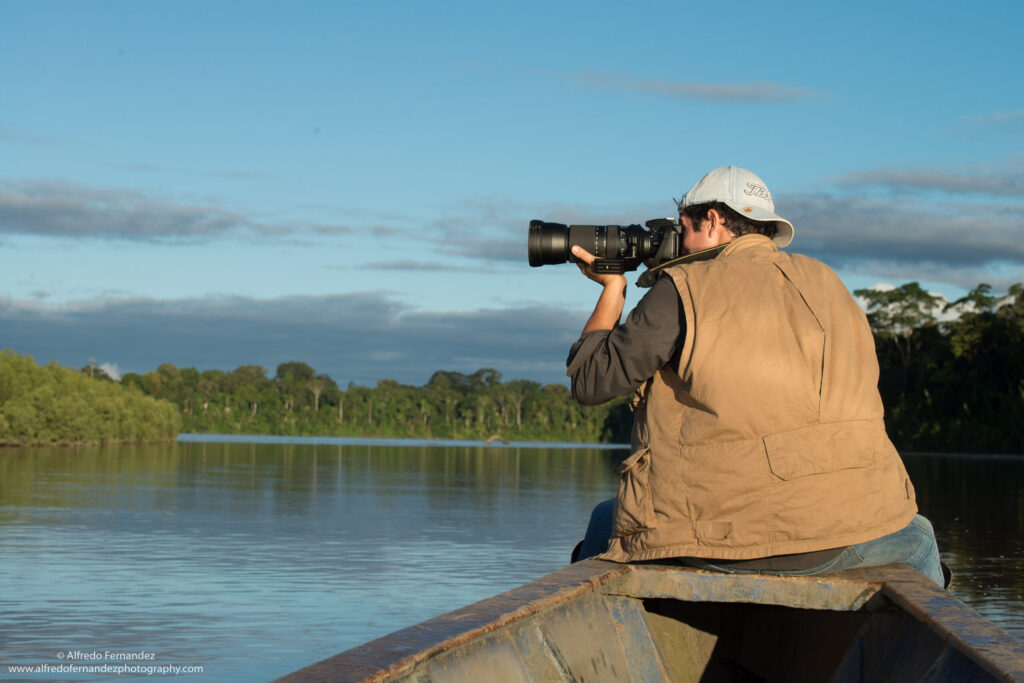Immersing into a tropical forest is as fascinating as overwhelming, especially for first-timers. Magnanimous tree trunks, charming birds shifting from branch to branch, regular chirping of insects, plus friendly but merciless dampness are all traditional of tropical conditions. Nonetheless, having the right resources, natural besides human– run, sets the perfect picture towards top-class birding and dedicated observation.

Stealing the show from birds and sighted swimming within the body of water which stretches toward the Macaw Claylick, a Giant otter (Pteronura brasilensis) was spotted by a National Geographic on assignment photographer catching a Bujurquina Syspilus individual for early breakfast.
“Much better than animal documentaries”.
Timothy (Germany), 1/10/10.
With this beautiful composition, fascinating landscape, local tradition and culture it’s easy to feel a connection with earth even as if you have stepped in the past.

“Today was the most beautiful birdwatching session I have ever had.”
Birder Einrich, natural from Austria during his visit3 on June 2011
The facilities offered within Tambo Blanquillo Private Nature Reserve harbors the ideal scenario for birding from the highest angle, high-class photography and a wide spectrum of biomes that merge on a keystone site: The Macaw Clay Lick.
You have built a fine observatory! Excellent!
John, retired carpenter from the United States after sharing his life-long passion for birds and sincere admiration during his last visit at our macaw clay lick blind
Carefully crafted to ensure the lowest footprint, this unique hide at Tambo Blanquillo Private Nature Reserve ‘s Clay Lick stands as an authentic observation marvel that serves to enhance the most out of the environment for wildlife sighting.
Rookie’s, regulars, amateur, semipro’s and certainly hardcore photographers, all know that a moving target is a much more difficult thing to shoot, especially when you are looking at it from a big lens which takes your world and sort of shrinks it down to this little environment.

Magnificent to see this spectacle in real life after all these years of looking at photographs and films. Extremely fortunate to have witnessed this spectacular event!
Australian traveler and ornithologist Andrew, could not hesitate to share his enthusiasm with us.
Situated at clay-wall-level (4 meters above the ground), with a surface area of 240 square meters, and 48 seats, this phenomenal blind provides plenty of space for setting-up your equipment, getting comfortable, and enable you to scout species in the area with ease and peace.

Got my NatGeo pic!
Ollie from Malta thrilled after tidying up his gear
Either to keep as a personal record, as ornament for the decoration of living space, or on behalf of the recollection of memories, there lies a priceless feeling when you witness direct eye-contact with a certain species clearly from a lens.
It is safe to say that after you see that image (either printed or mentally), it won’t take much to realize this mysterious connection with nature that unravels entirely when seizing that moment through a lens, or by observing such specie close-enough to grasp its essence. Connectivity of that sort enables the formation of this animal-human bond, nothing less than an odd but natural link of profound involvement with that animal at a high degree of intimacy.

Amazing to see these birds in wild as they should be. Sending lots of love to these amazing creatures
Carl who reveals this feeling of amazement exposed at Tambo Blanquillo Private Nature Reserve’s Macaw Clay Lick
Top blind filming can serve as means to achieve an occasional distraction, a way to observe nature closer, and the chance to connect with the sereneness of the setting that offers zero disturbances; the perfect bridge towards placing nature under a microscope to register uppermost wildlife footage.

A great contribution towards life, its observation, and this wonderful activity of birds. Congratulations and thank you very much!
Christian from Norway
With over 1,025 different bird species traversing through the Manu road into the Madre de Dios River, an average visitor may be able to see up to 900 distinct birds with just over a week trip.
If you cross the environment side-by-side with someone who really knows what they are doing, such as a field guide, a biologist, an ornithologist who really understands the environment and its ecosystems, all of a sudden, they can bring things right in front of you. That is a must and we at Tambo Blanquillo care about providing the best Amazon forest guides.

To see an ocelot catch a macaw, a real David Attenborough moment!
Marlene native from the UK
That’s what makes birdwatching at the blind in Tambo Blanquillo so remarkable, as our guests have expressed, it’s this combination of optimal premises well-fixed around animal hot-spots, plus a prime level guidance service that makes you enjoy this atmosphere, feel younger, and deeply connected with while being relaxed, free and take in the excitement of exploring. Having this opportunity can be sort of a once-in-a-life-time experience.

Loved getting here! This place is a big mystery and amazing. It was so wonderful we just couldn’t stop ourselves from (expressing), crying out loud in excitement…!
Naomi, Canadian guest during the season in 2012
Take a time and sense the thrill expressed by our visitors after venturing into this fabulous journey of blind birdwatching.

I wish I had a clay lick in my backyard
Brook during 2017
Her enthusiasm was worthwhile considering she made it back with her grandchildren a year later.
A seasoned birder once mentioned, “It is not only about numbers, but about the habitats and behaviors of the birds we are enjoying.” TRAVEL WITH PURPOSE, bird at Tambo Blanquillo Private Nature Reserve, we are confident you will RETURN INSPIRED.






